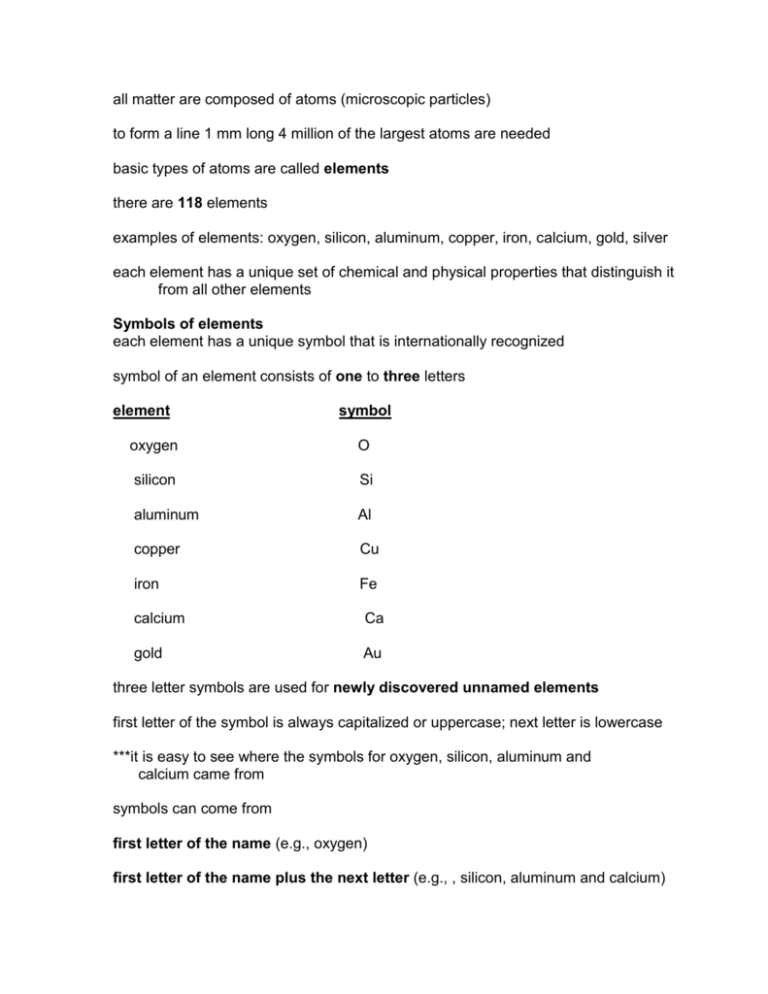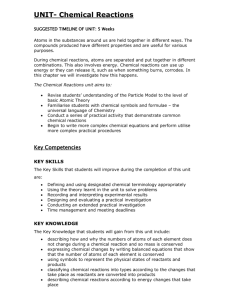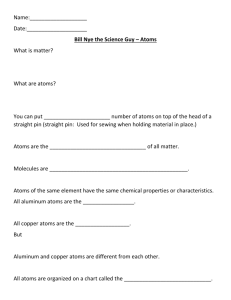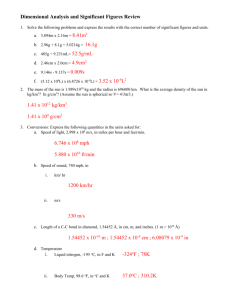chapter 1-3
advertisement

all matter are composed of atoms (microscopic particles) to form a line 1 mm long 4 million of the largest atoms are needed basic types of atoms are called elements there are 118 elements examples of elements: oxygen, silicon, aluminum, copper, iron, calcium, gold, silver each element has a unique set of chemical and physical properties that distinguish it from all other elements Symbols of elements each element has a unique symbol that is internationally recognized symbol of an element consists of one to three letters element symbol oxygen O silicon Si aluminum Al copper Cu iron Fe calcium Ca gold Au three letter symbols are used for newly discovered unnamed elements first letter of the symbol is always capitalized or uppercase; next letter is lowercase ***it is easy to see where the symbols for oxygen, silicon, aluminum and calcium came from symbols can come from first letter of the name (e.g., oxygen) first letter of the name plus the next letter (e.g., , silicon, aluminum and calcium) first letter of the name plus a later letter in the name magnesium Mg chlorine Cl zinc Zn plutionium Pu other symbols for elements came from the Latin name Latin was the language of many early chemists Cu cuprum Fe ferrum Au aurum other symbols for elements came from the German name W wolfram (German word for tungsten) names of elements 1. some elements have been named in honor of a person Seaborgium from Glenn Seaborg, an American chemist and Nobel Prize winner who helped isolate and identify elements 94 -102 Einsteinium from Albert Einstein Curium from Marie and Pierre Curie who first discovered radioactivity 2. some elements have been named after places americium (the America) europium (Europe) californium (California state) berkelium (Berkely, California) francium (France) 3. some elements have been named after the planets plutonium (planet Pluto) neptunium (planet Neptune) uranium (planet Uranus) Hydrogen - most common element more than 90% of the atoms in the known universe are hydrogen atoms living things are composed primarily of four elements C, H, O, N in 1750 only 16 elements were known (e.g., gold, carbon, copper, iron, lead, mercury, platinum, silver) elements may exist as single atoms or as molecules e.g., Helium, used to fill balloons exist as individual atoms (monoatomic) molecule - consist of two or more atoms in a definite ratio (generally composed of non-metals only) - may consist of two or more atoms of the same elements or atoms of different elements Nitrogen, N2 is diatomic diatomic means each molecule contains 2 atoms of the same type other diatomic molecules are H2, O2, and the halogens other elements which exist as molecules P4, S8 some elements have allotropic forms allotrope - one of a number of different molecular or crystalline forms of the element oxygen has two allotropes O2 gas that we breathe O3 ozone, toxic produced by electric discharge through air you can smell ozone when separating clothes stuck together by “static cling” or after an intense thunderstorm carbon has four allotropes 1. graphite - soft gray solid with slippery texture 2. diamond - hardest substance on Earth 3. buckyball - 60-C molecule 4. buckytube







